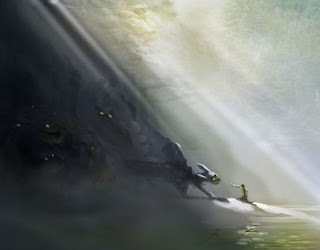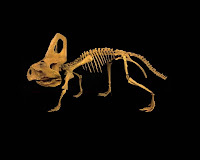Staurt Sumida gave a talk that followed dinosaurs through animation history. starting with the most important Gerty the dinosaur by Winsor Mckay and leading on through Disney's Fantasia and "the right of spring". Stuart remarked on how incredibly the stegosaurus's back plates were precisely right in their placement in Fantasia whilst science only very recently found that they were stood in this postion after slating the film for misrepresentation on its release. Another example of Disney prediction of science was the feathered dinosaur featured in Fantasia, now named "Archaeoptrics". Disney were the first to find feathers on dinosaurs, this is a brilliant fact that I will revel in telling people.
Jurassic Park, a major contributor to the popularity of dinosaurs in film gave new life and realism to the prehistoric reptiles. The dinosaurs of Jurassic Park in Stuart's and of course my opinion are brilliant and the film brought fame to Raptors who were relatively unknown before. Bob Kurtz animator of a dinosaur short in the 60's created the Mr DNA sequence for the first Jurassic park. The Franchise did hold some inaccuracies which Stuart has spotted including the Bracheasaurus of the 1st film jumping up on its hind legs, this is physically impossible and its sheer weight would have broken its legs. Another is the Spinosaurus of the 3rd film and its supposed conflict with the TRex. The TRex would have owned the Spinosaur, its scale was exaggerated in the film and the creature was in fact a fish eater so would not have eaten meat. These are interesting points but film does not always have to be accurate in its science. Disney's CG film Dinosaur featured an Oviraptor that raided dinosaur nests and feasted on eggs. Science has found that it's fossils, laid near eggs, were due to their nurturing of eggs and not diet. Night at the Museum was one of Stuart's best examples of dinosaur anatomy, this same TRex model was then built on by studio Rhythm and Hues when creating Land of the Lost the recent Will Ferrel film.
Stuart went on to List his top 10 Dinosaurs of Animation:
- Gertie
- Fantasia Dinosaurs
- Ceratopsaurs of "Dinosaur" by Disney
- "Grumpy" TRex of Land of the Lost
- TRex skeleton Night at The Museum
- Jurassic Park
- Original King Kong TRex
- Stop motion 10,000 years BC dinosaurs
- CG King Kong dinosaurs
- Bob Kurtz Animated Dinosaurs
- crocodiles
- dinosaurs
- pterosaurs
- bats
- birds
Crocodiles are especially special in this list due to their galloping runs. A crocodile will fly through the air as they run which is terrific reference for dragon animation due to their similarities in body shape. The film Reign of Fire focussed more on the Bird/Bat influence and ultimately produced a more graceful and wing orientated dragon. A pet peave of dragon design for Stuart is the addition of a hook on the elbow, this is not a factor to any existing creatures anatomy and serves no purpose on the limb if it did. That concludes the little dragon information Stuart Sumida gave at this talk or at least the information i managed to jot down on paper. He finished with his personal top 5 dragons of Animation
- Mushu of Disney's Mulan
- Maleficent of Disney's Sleeping Beauty
- Vermithrax of Dragon Slayer
- Reign of Fire
- Hungarian Horntail of Harry Potter
I hope this interesting to people. If anyone is thinking of creating a dinosaur or dragon for an animation then all of the resources mentioned above are invaluable. I can do my best to put you through to Stuart Sumida if you do have any design or rigging problems that you really seem stuck with. I shall post more on Dreamworks when I eventually get to Mark Osbourne's talk in my notes.




No comments:
Post a Comment